Research on the Response Mechanism of Coal Rock Mass under Stress and Pressure
Abstract
:1. Introduction
2. Experimental Design and Conditions
2.1. Sample Preparation
2.2. Design of Experiments
2.3. Experimental System
3. Analysis of Coal Rock Mechanical Response Results
3.1. Analysis of Basic Mechanical Parameters of Bearing Coal Rock Samples
3.2. Analysis of Stress–Strain Curve in the Whole Process of Bearing Coal Rock Samples
3.3. Coulomb Strength Guidelines
3.4. Analysis of Failure Mode of Bearing Coal Rock Samples
4. Characteristic Analysis of Coal Rock Characteristic Strength Parameter Response
4.1. Definition and Description of the Character Strength of Bearing Coal Rock Samples
- (1)
- Compaction (elastic) strength point of bearing coal rock sample: Due to the existence of natural joint fractures in the coal rock mass, when the axial stress is at a low range, the primary fracture is compressed and closed, and the stress–strain curve of the whole process has prominent internal concave segments. Additionally, because coal rock is a typical elastoplastic body, many primary fractures enter the elastic deformation stage after closing. It can also be called the starting point of the elastic deformation stage.
- (2)
- The Plastic strength point of bearing coal rock sample: as the stress continues to increase, the elastic deformation stage and the stress–strain have a typical linear relationship; as mentioned earlier on the elastic-plastic characteristics of the bearing coal rock mass, when the stress exceeds the plastic point, the curve will slowly begin to move away from the original linear trend and then continue to form irreversible damage accumulation until the peak strength is reached. Therefore, the starting point of the initial deviation from the linear phase is used as the plastic strength point of the bearing coal rock specimen. It can also be called the end point of the elastic deformation stage.
- (3)
- The peak intensity point of the bearing coal rock sample: This is the point corresponding to the maximum stress value in the stress–strain curve, and the axial deformation corresponding to this point is the peak strain.
- (4)
- The residual strength point of the bearing coal rock sample: The bearing coal rock sample has typical brittle characteristics. The progress of servo control technology of rigid testing machines can ensure that the post-peak curve can be obtained during the rock mechanics test. During post-peak unloading, the damage increases, but the load-bearing coal rock specimen still has a load-bearing structure, so the smallest strength value in the curve corresponds to the residual strength point.
4.2. Characteristic Strength Evolution Characteristics of Bearing Coal Rock Samples
- (1)
- Analysis of elastic modulus and confining pressure of bearer coal rock samples
- (2)
- Analysis of peak strength and confining pressure of bearing coal rock samples
- (3)
- Analysis of peak strain and confining pressure of bearing coal rock samples
5. Evolving Law of Proportion of Bearing Coal Rock Stage
5.1. Analysis of the Proportion of Bearing Coal Rock Stage
5.2. Strength Analysis of the Evolution Stage of Bearing Coal Rock
- (1)
- Strength analysis of coal rock compaction stage
- (2)
- Strength analysis of the plastic stage of coal rock
- (3)
- Analysis of residual strength of bearing coal rock samples
6. Discussion
7. Conclusions
- (1)
- The total stress–strain curve of coal rock under the same confining pressure conditions can be divided into four stages, namely, the four steps after pore fracture compaction, elastic deformation, yield, and rupture. The uniaxial compression is the same as the triaxial compression process. The various stages of coal rock show different changes, and the strength of the two coal rocks is more robust under the action of confining pressure, which enhances the bearing capacity of coal rock;
- (2)
- Under the conditions of 0 MPa, 3 MPa, 6 MPa, and 9 MPa, the proportion of the two groups of coal rock specimens in the pore fracture compaction stage continued to decrease, which was negatively correlated with the confining pressure. The elastic deformation stage increases in proportion through the whole process, which is positively correlated with the confining pressure. Plastic deformation positively correlates with confining pressure, which increases with increased confining pressure. The confining pressure increased, and the two coal rocks were transformed from the initial brittle characteristics to plastic;
- (3)
- Due to the pore structure of the coal rock itself, with the increase in confining pressure, the strength of the compaction stage of the coal rock continues to decrease, and the elastic modulus of the coal rock sample increases. The elastic modulus of fine sandstone is greater than that of the coal rock specimen; the degree of change of the coal rock specimen with the confining pressure is greater, and the mechanical properties of the coal rock in this process are very different. As the confining pressure increases, the peak strength of the coal rock sample increases, the residual power increases, and the effects of confining pressure on the mechanical characteristics of the coal rock specimen at each stage are more prominent.
Author Contributions
Funding
Institutional Review Board Statement
Informed Consent Statement
Data Availability Statement
Conflicts of Interest
References
- He, M.; Xie, H.; Peng, S.; Jiang, Y.D. Study on the mechanics of deep mining rocks. Chin. J. Rock Mech. Eng. 2005, 24, 2803–2813. [Google Scholar]
- Hokka, M.; Black, J.; Tkalich, D.; Fourmeau, M.; Kane, A.; Hoang, N.H.; Li, C.C.; Chen, W.W.; Kuokkala, V.T. Effects of strain rate and confining pressure on the compressive behavior of Kuru granite. Int. J. Impact Eng. 2016, 91, 183–193. [Google Scholar] [CrossRef]
- Xie, H.; Gao, F.; Ju, Y. Research and development of rock mechanics in deep grounden gineering. Chin. J. Rock Mech. Eng. 2015, 34, 2161–2178. [Google Scholar]
- Sukplum, W.; Wannakao, L. Influence of confining pressure on the mechanical behavior of Phu Kradung sandstone. Int. J. Rock Mech. Min. Sci. 2016, 86, 48–54. [Google Scholar] [CrossRef]
- Ma, L.Q.; Sun, H.; Ngo, I.; Han, J. Infrared radiation quantification of rock damage and its constitutive modeling under loading. Infrared Phys. Technol. 2022, 121, 104044. [Google Scholar] [CrossRef]
- Xu, H.; Lai, X.; Zhang, S.; Shan, P.; Wu, Z.; Xu, H.; Bai, R.; Guo, Q. Precursor Information Recognition of Rockburst in the Coal-Rock Mass of Meizoseismal Area Based on Multiplex Microseismic Information Fusion and Its Application: A Case Study of Wudong Coal Mine. Lithosphere 2022, 7349759. [Google Scholar] [CrossRef]
- Ibemesi, P.; Benson, P. Effect of Pressure and Stress Cycles on Fluid Flow in Hydraulically Fractured, Low-Porosity, Anisotropic Sandstone. Rock Mech. Rock Eng. 2023, 56, 19–34. [Google Scholar] [CrossRef]
- You, M. Influence of confining pressure on strength of rock specimen and its discreteness. Chin. J. Rock Mech. Eng. 2014, 33, 929–937. [Google Scholar]
- Feng, G.; Zhu, C.; Wang, X.; Tang, S. Effects of different temperatures on the accuracy of the MMTS criterion in predicting fracture behavior of dense granite from a potential geothermal development area. J. Rock Mech. Geotech. Eng. 2022. [Google Scholar] [CrossRef]
- Ma, L.; Zhai, J.; Ngo, I. Experimental Study on Preparation of Negative Carbon Filling Material for Water Protection Mining by CO2 Mineralization of Coal-based Solid Waste. J. China Coal Soc. 2022, 1049. [Google Scholar] [CrossRef]
- Xu, H.; Lai, X.; Shan, P.; Yang, Y.; Zhang, S.; Yan, B.; Zhang, Y.; Zhang, N. Energy dissimilation characteristics and shock mechanism of coal-rock mass induced in steeply-inclined mining: Comparison based on physical simulation and numerical calculation. Acta Geotech. 2022, 18, 843–864. [Google Scholar] [CrossRef]
- Song, H.; Zhao, Y.; Jiang, Y.; Zhang, X. Effect of coal rock heterogeneity on its failure characteristics under uniaxial compression conditions. J. Coal Sci. Technol. 2017, 42, 3125–3132. [Google Scholar]
- Xu, H.; Lai, X.; Zhang, S.; Zhang, Y.; Shan, P.; Zhang, X.; Liu, B.; Wan, P. Multiscale intelligent inversion of water-conducting fractured zone in coal mine based on elastic modulus calibration rate response and its application: A case study of Ningdong mining area. Lithosphere 2021, 2021, 6304624. [Google Scholar] [CrossRef]
- Zhang, C.; Pan, J.; Xia, Y.; Yang, G. Study on the impact failure characteristics of combined coal rock under the condition of true triaxial plus unloading. Chin. J. Rock Mech. Eng. 2020, 39, 1522–1533. [Google Scholar]
- Feng, G.; Zhu, C.; Wang, X.; Tang, S. Thermal effects on prediction accuracy of dense granite mechanical behaviors using modified maximum tangential stress criterion. J. Rock Mech. Geotech. Eng. 2022, in press.
- Liu, X.; Yu, J.; Kang, J.; Hao, Q. Study on the strength and deformation characteristics of coal rocks under different confining pressures. Chin. J. Undergr. Space Eng. 2019, 15, 1341–1352. [Google Scholar]
- Cu, C.; Li, H.; Liu, Y.; Wang, G.; Zhang, L.; Wang, D. Experimental study on the influence of equivalent confining pressure on mechanical properties of coal rock under true triaxial conditions. Coal Sci. Technol. 2018, 46, 47–53. [Google Scholar]
- Xiao, T.; Huang, M.; Li, X. Study on the strength deformation characteristics of deep buried Dali rock considering the confining effect. Chin. J. Undergr. Space Eng. 2018, 14, 362–368. [Google Scholar]
- Zhang, Z.; Gao, F. Study on the confining effect of the energy evolution of the loaded rock. Chin. J. Rock Mech. Eng. 2015, 34, 1–11. [Google Scholar]
- Wang, H.; Yang, T.; Yu, Q.; Zhao, Y.; Wang, P. Mechanical characteristics and constitutive relationships of sandstone in Yuheng Mining Area under different confining conditions. J. Coal Soc. 2015, 40, 320–327. [Google Scholar]
- Ren, F. Mechanical characteristics and failure modes of coal rock under triaxial compression. Coal Mine Saf. 2018, 49, 37–39+43. [Google Scholar]
- Cu, L.; Zhang, M.; Wang, J.; Wang, C.; Du, J. Analysis of damage deformation law and acoustic emission characteristics of coal rock under different confining pressures. China Saf. Prod. Sci. Technol. 2019, 15, 18–24. [Google Scholar]
- Liu, Q.; Liu, K.; Zhu, J.; Lu, X. Study on triaxial compression mechanical characteristics of raw coal under high stress. Chin. J. Rock Mech. Eng. 2014, 33, 24–34. [Google Scholar]
- Zhang, P.; Xu, D.; Zhang, R.; Zhang, X.; Dong, Y.; Mu, W. Experimental study on seepage and mechanical characteristics of sandstone under different confining pressure and circulating load. Chin. J. Rock Mech. Eng. 2022, 41, 2432–2450. [Google Scholar]
- Cai, M.F.; He, M.C.; Liu, D.Y. Rock Mechanics and Engineering; China Science Publishing & Media Ltd.: Beijing, China, 2002. [Google Scholar]
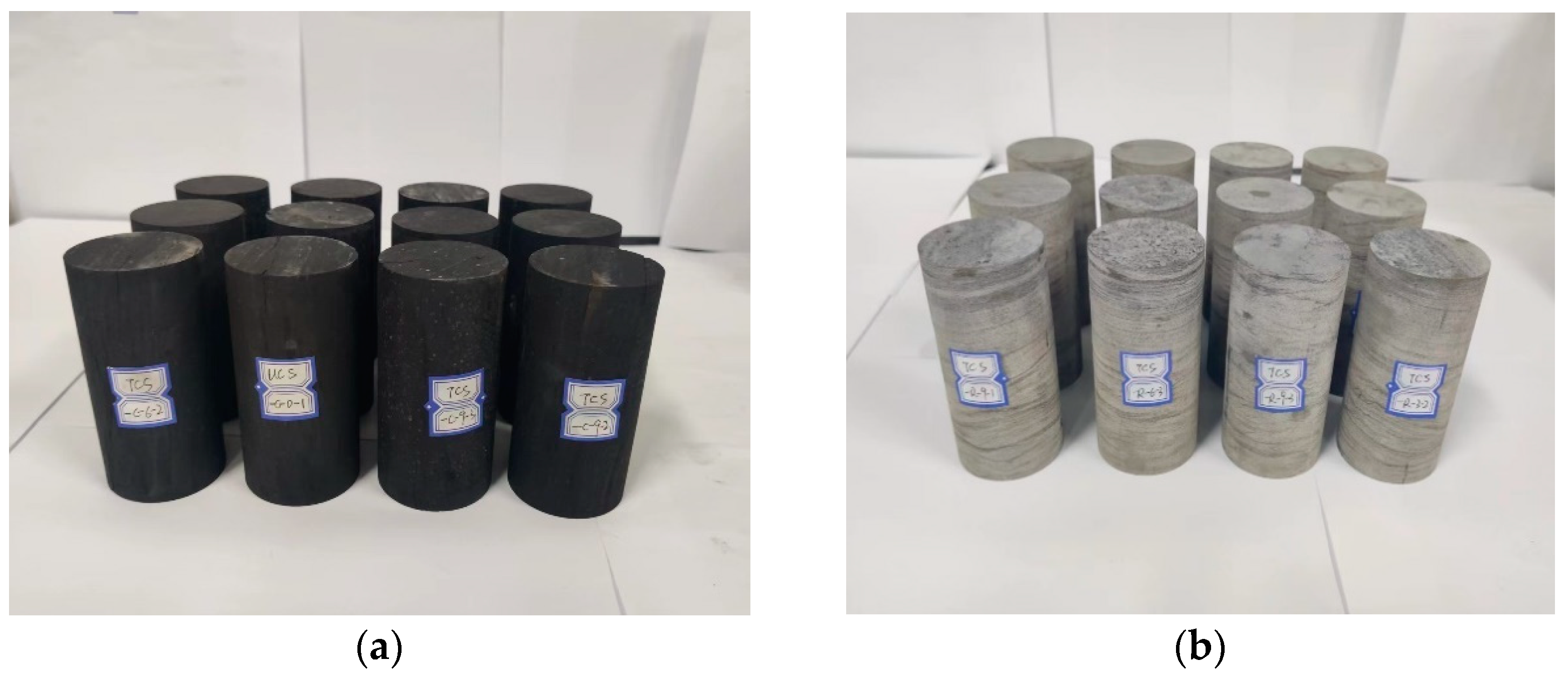


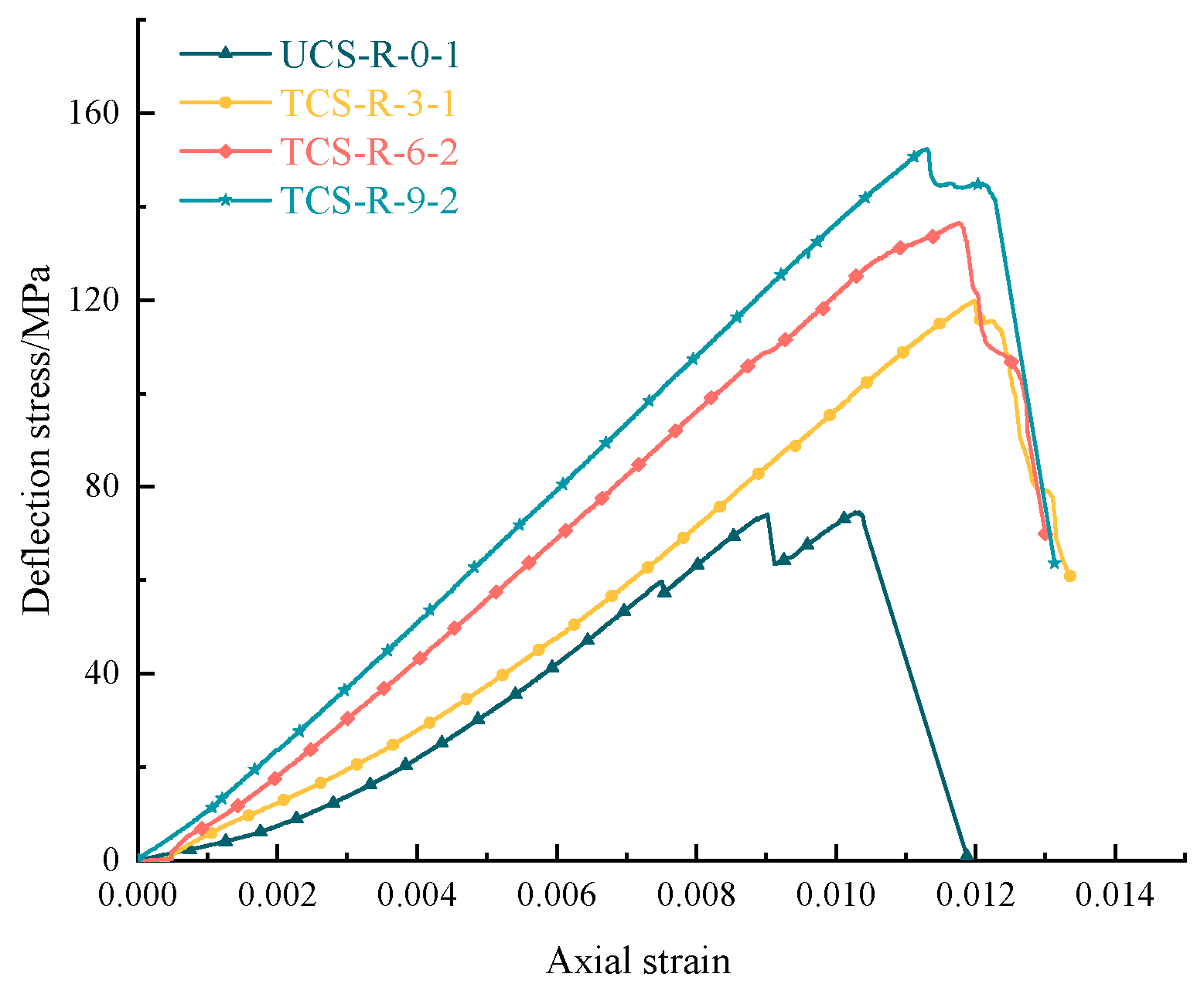

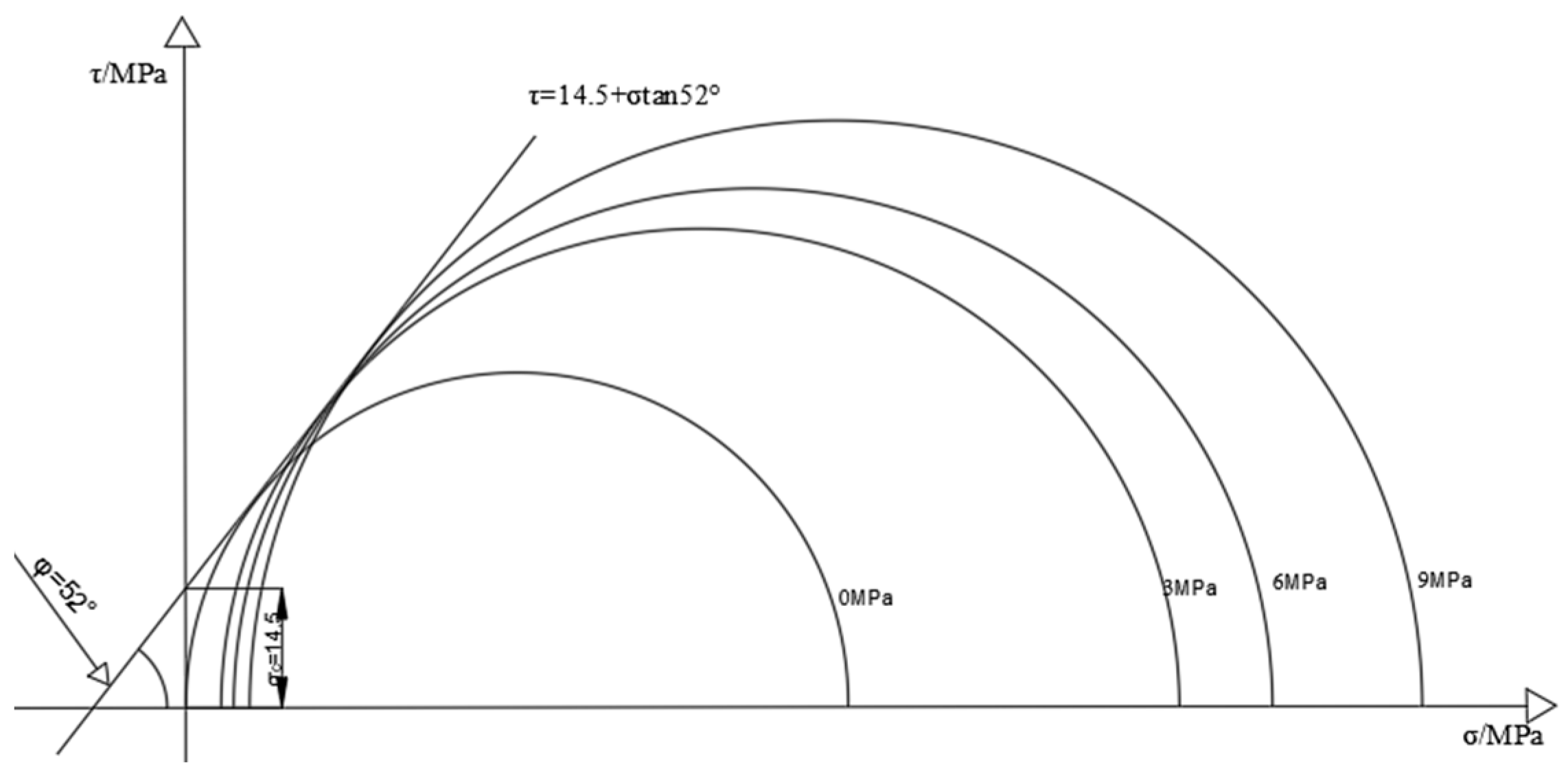


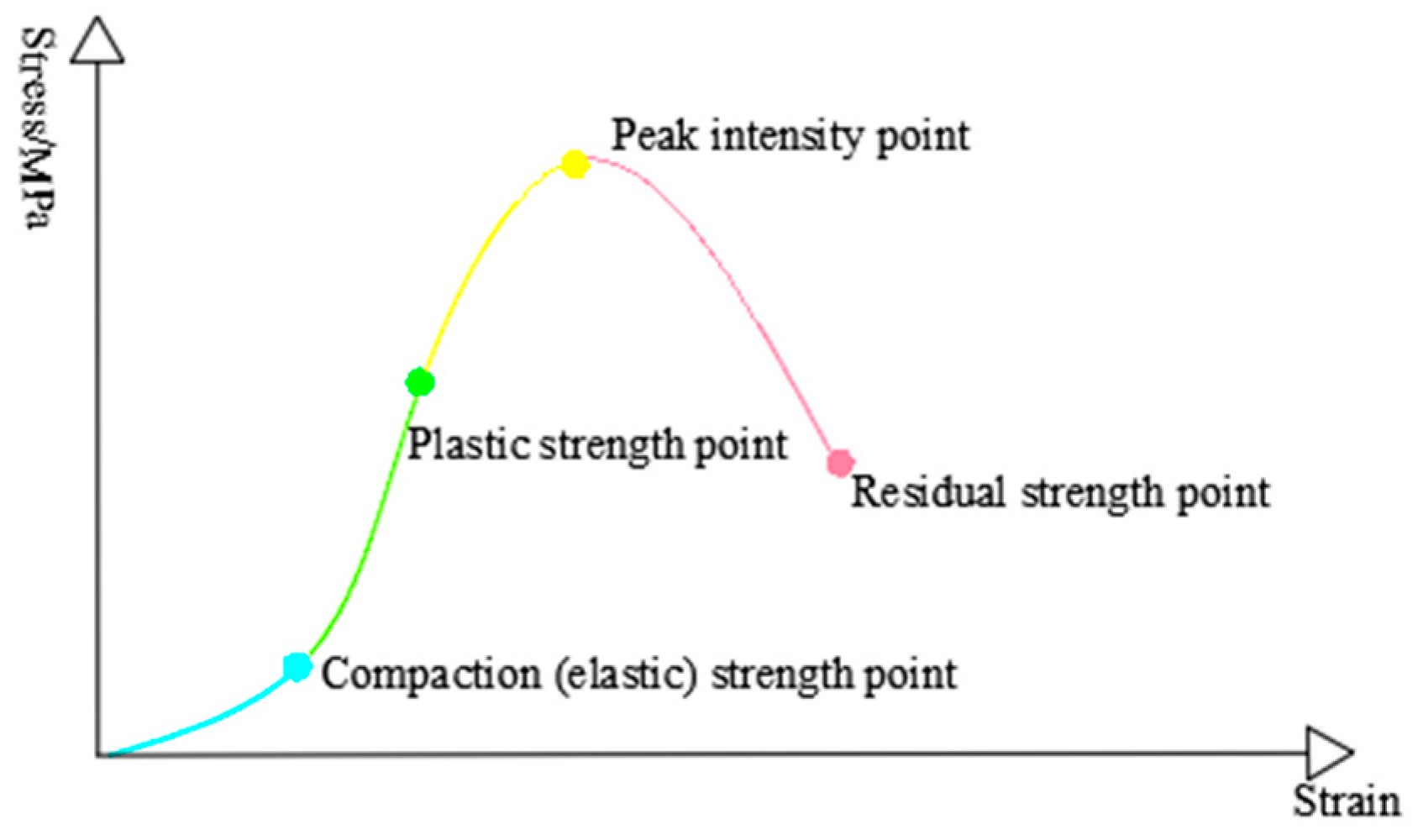
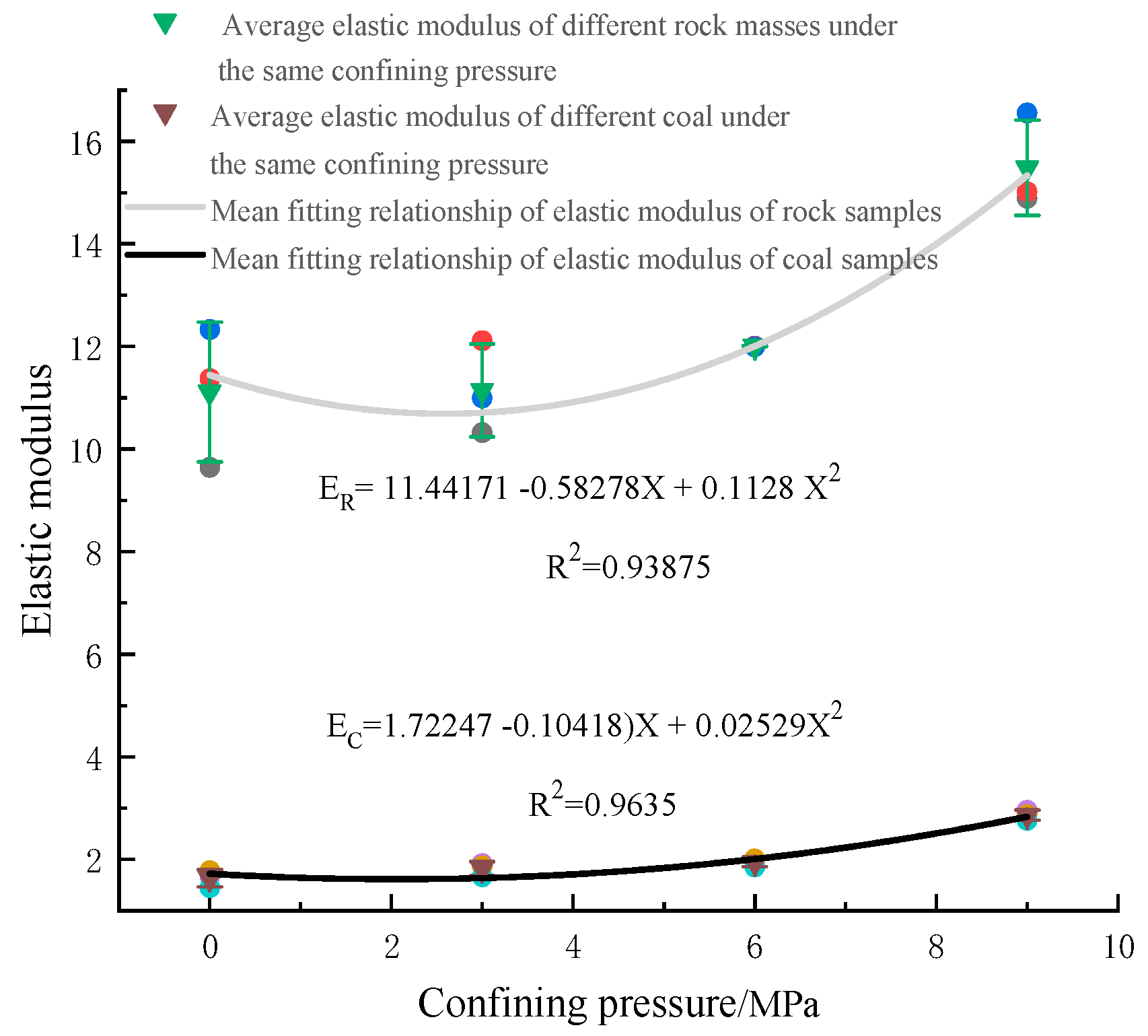
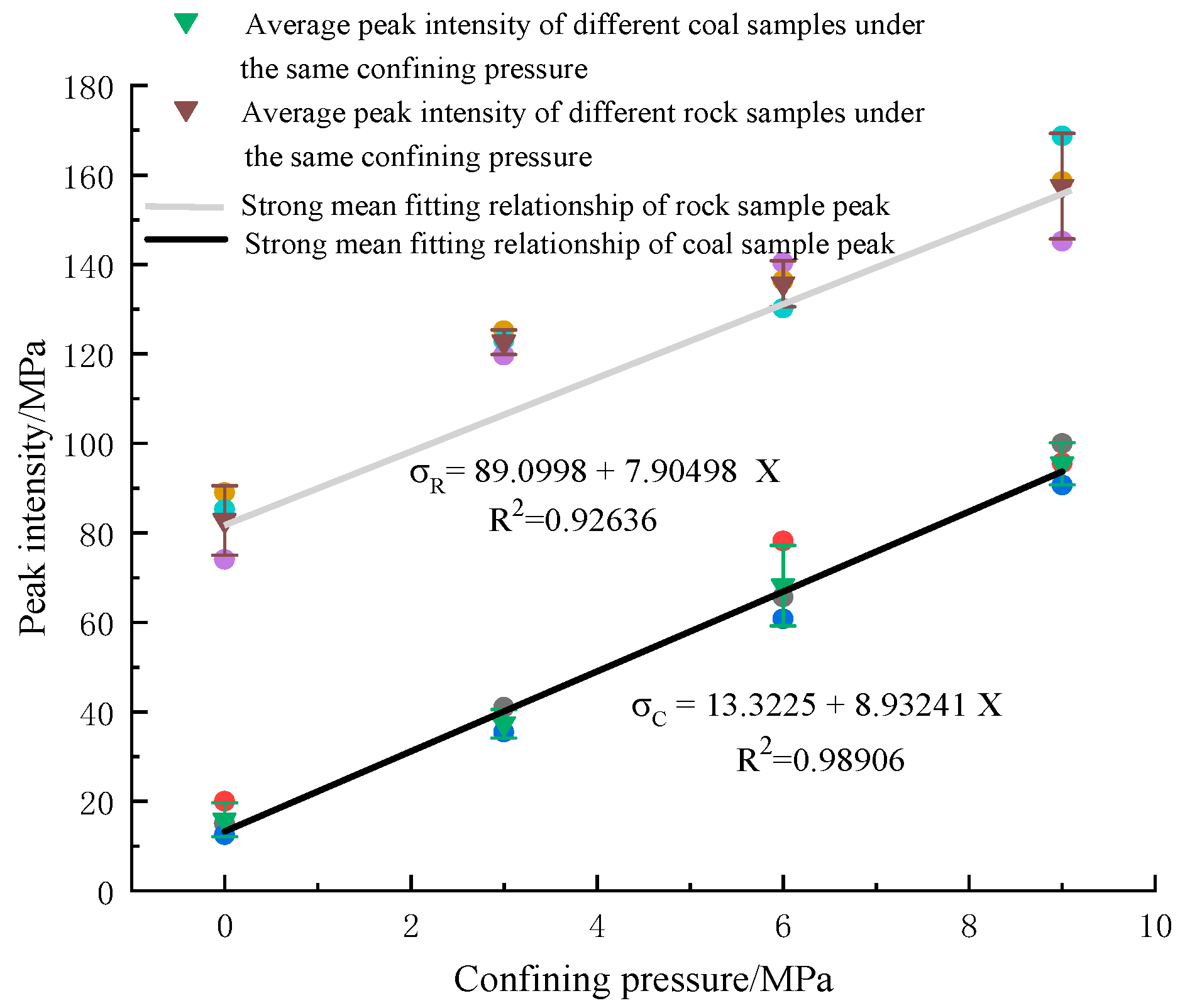
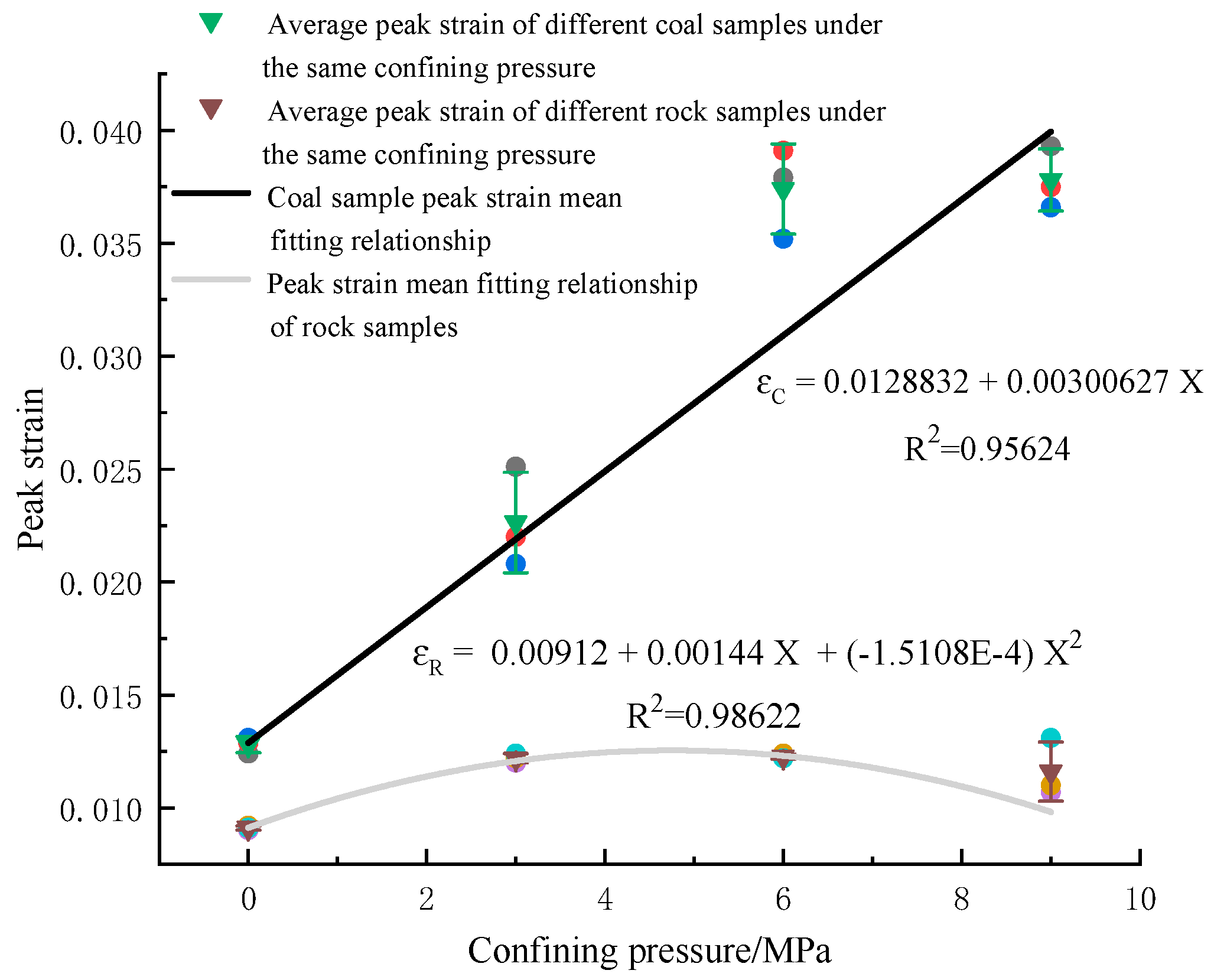

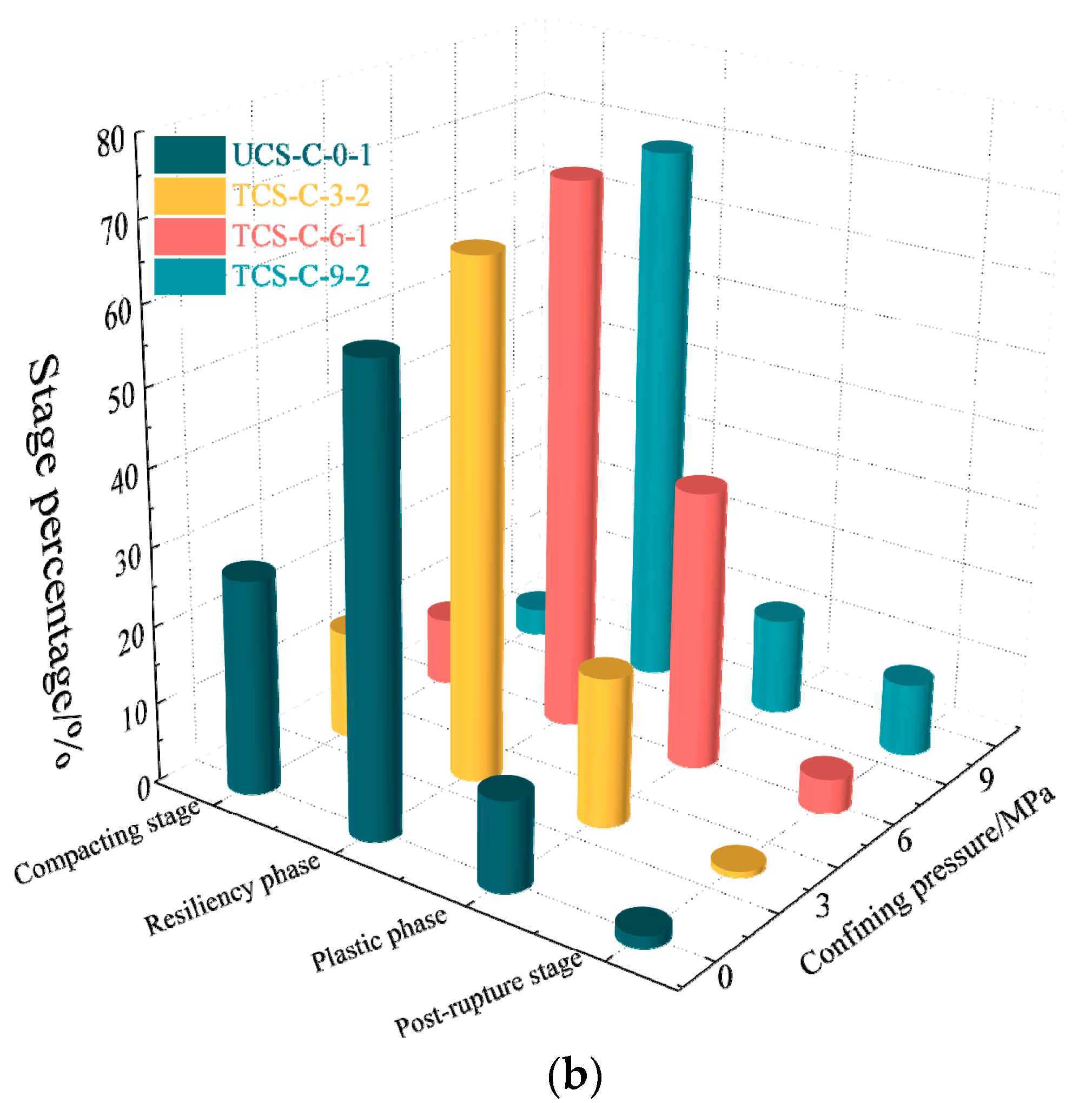
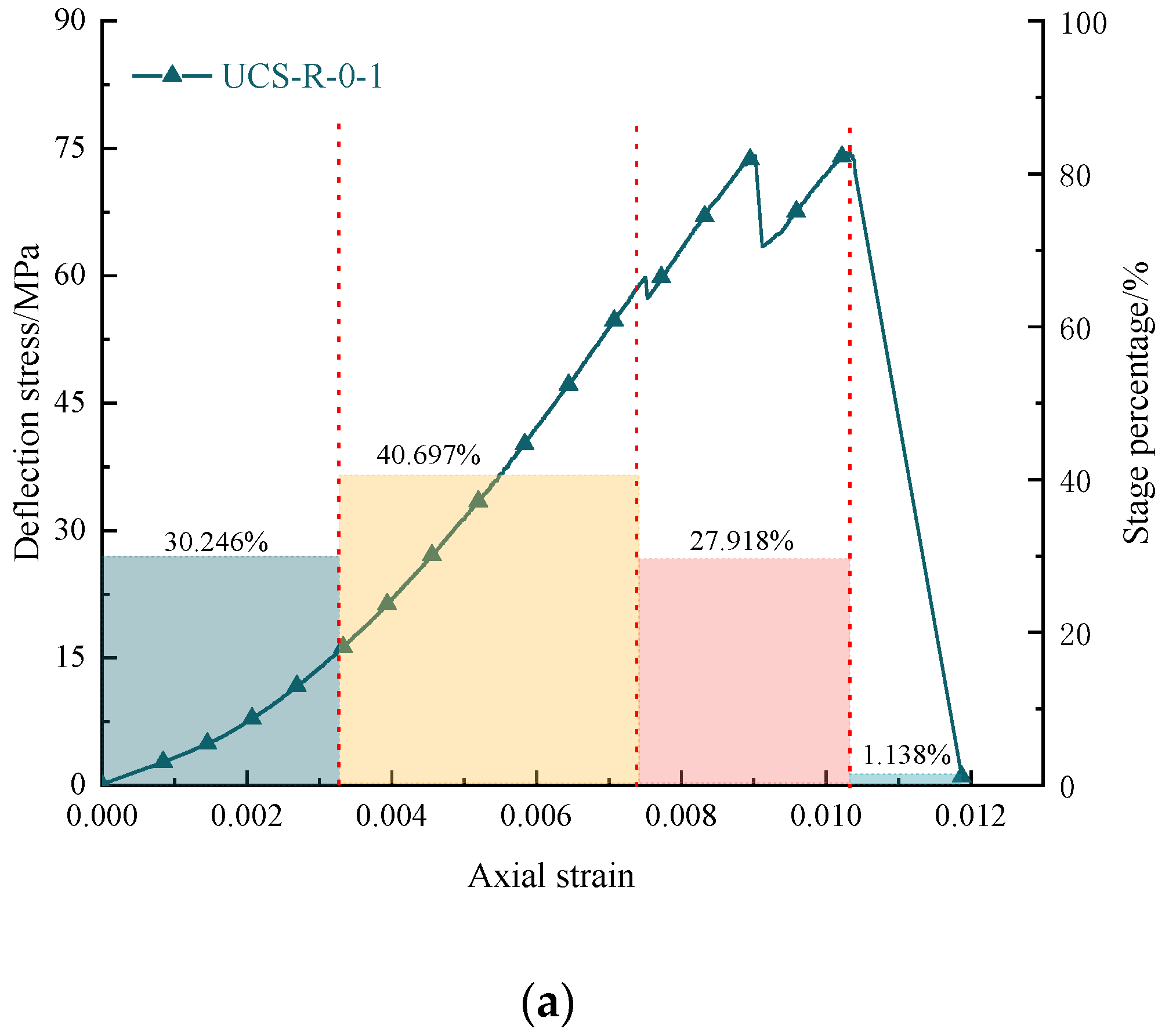
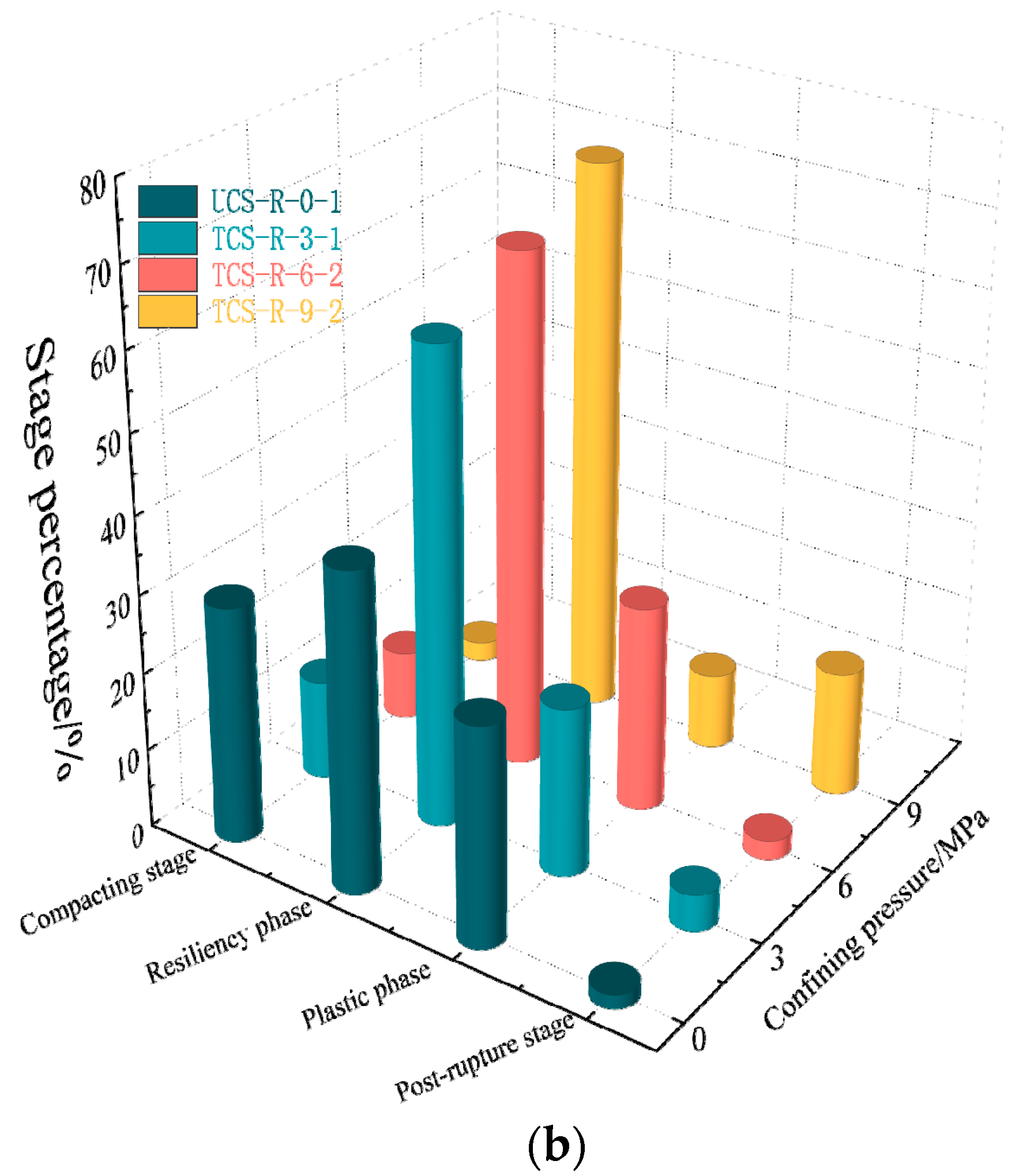
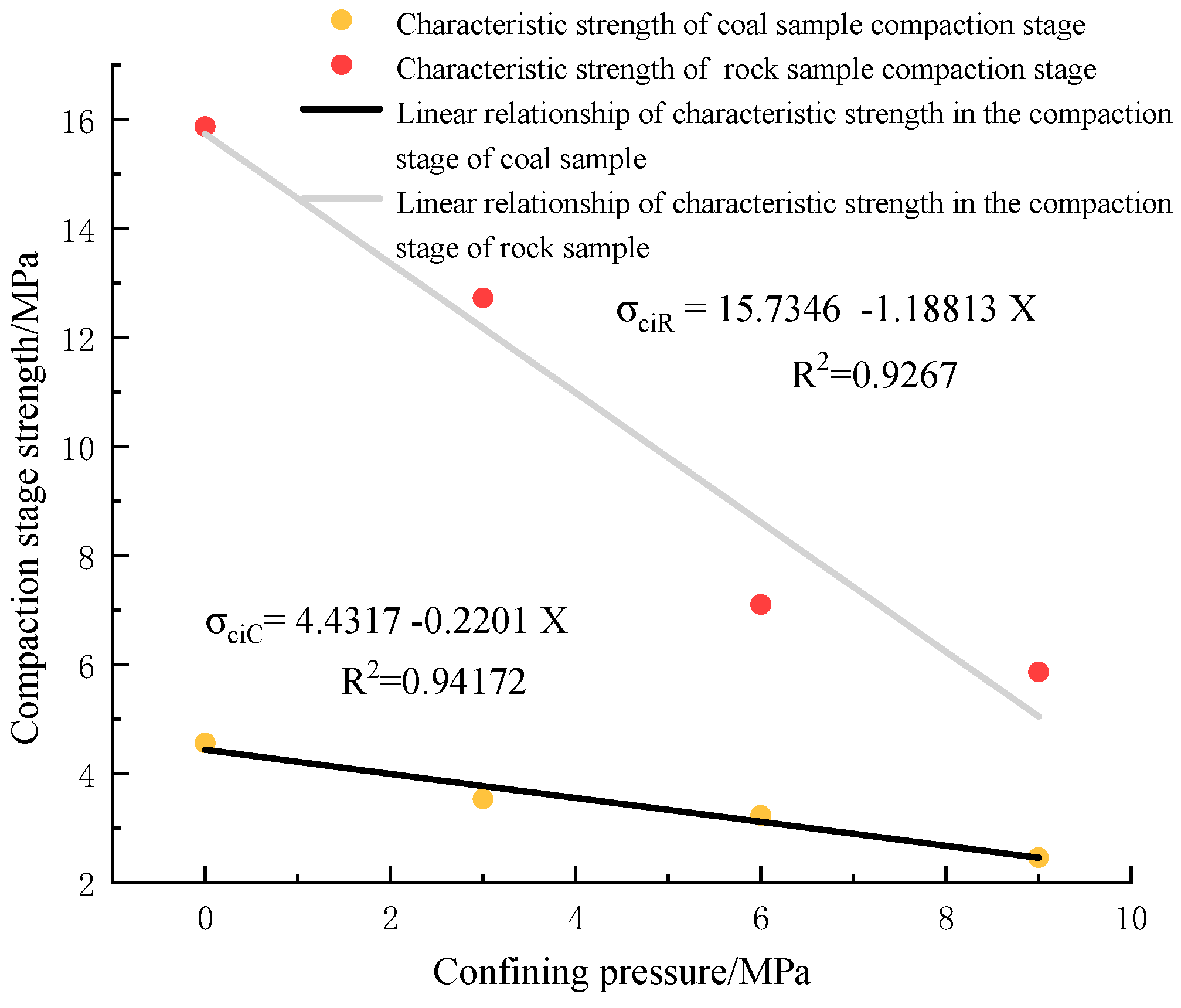
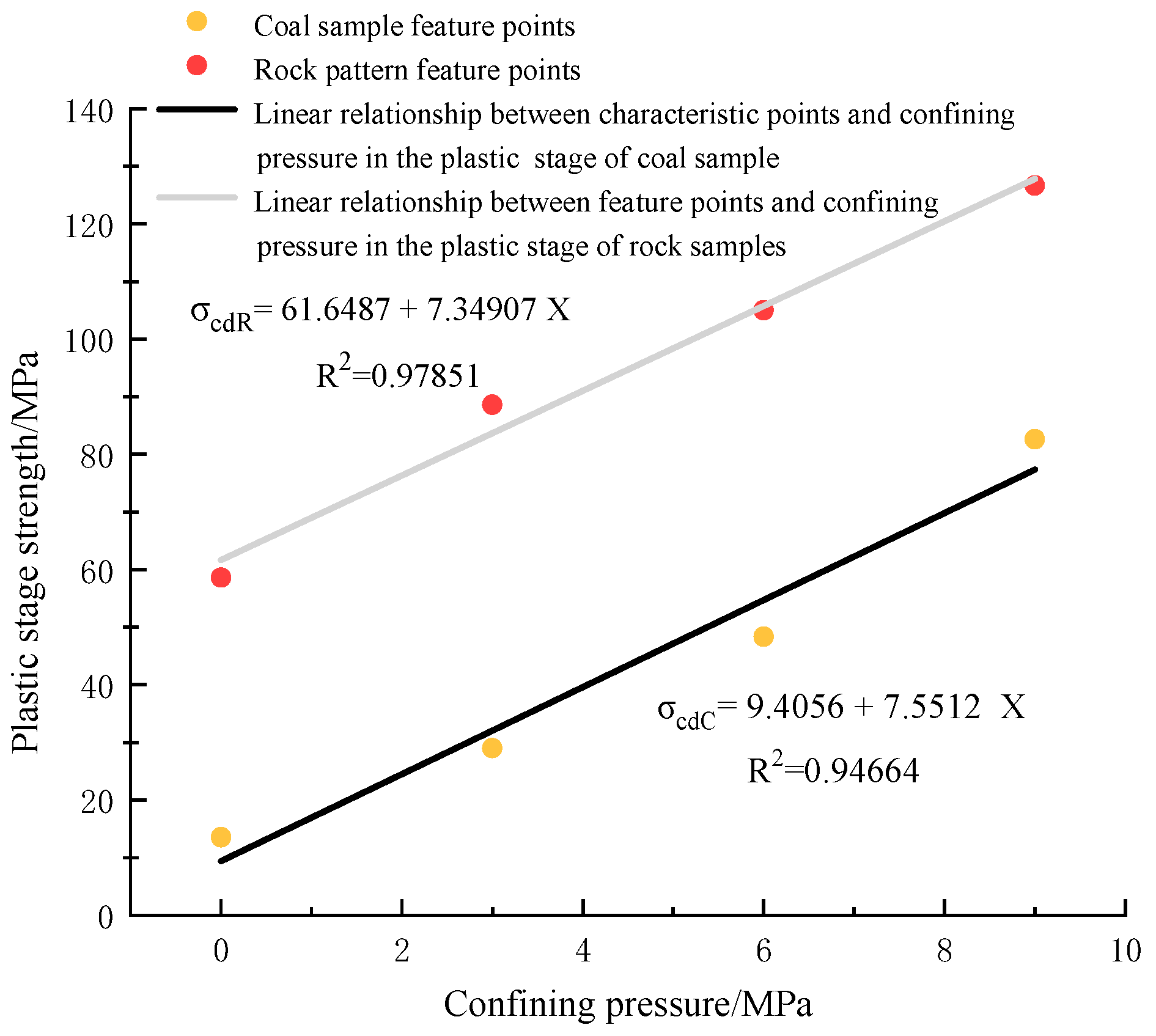
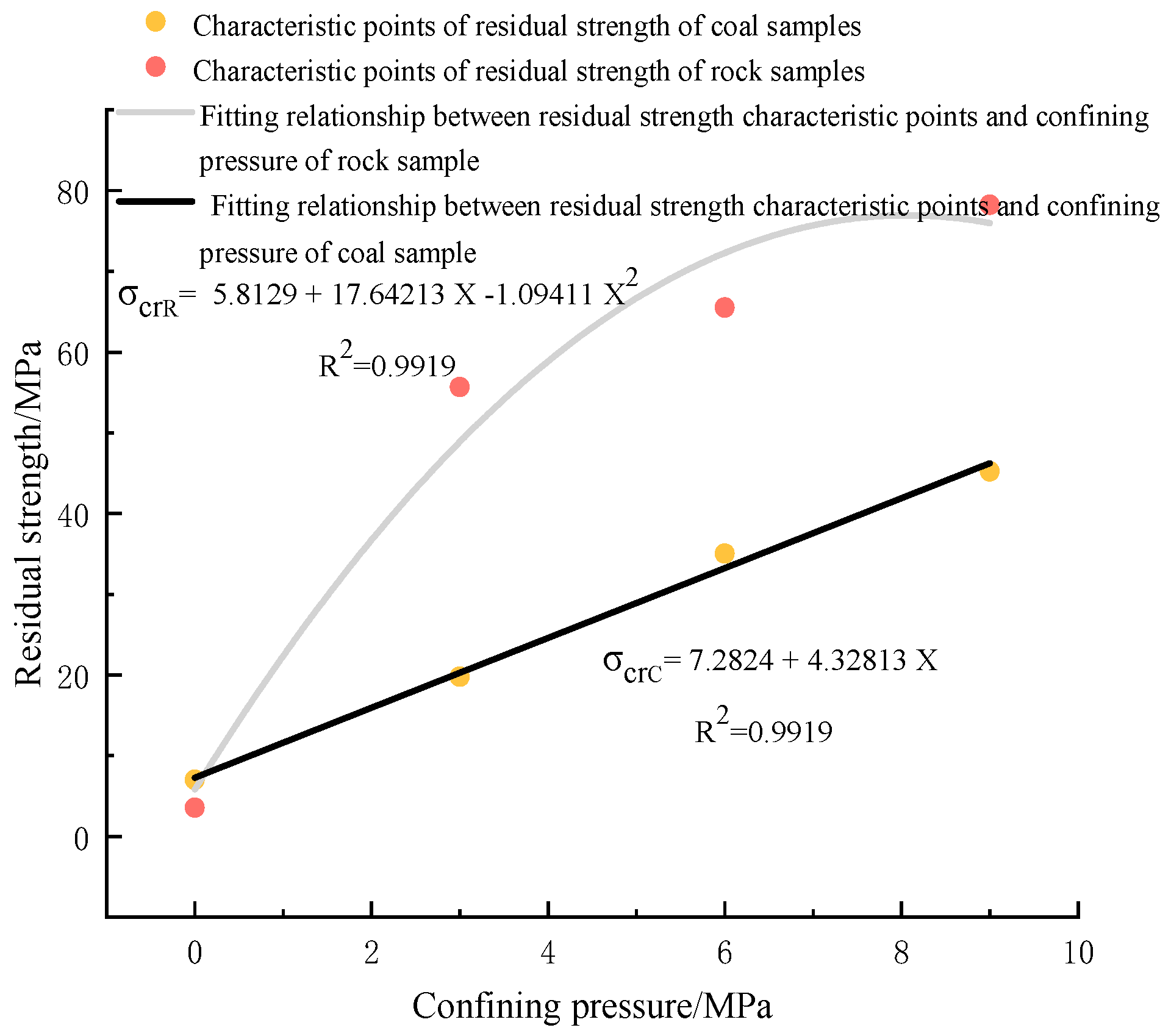
| Specimen Number | Peak Intensity/MPa | Peak Strain | Young’s Modulus/GPa |
|---|---|---|---|
| UCS-C-0-1 | 15.074 | 0.0124 | 1.670 |
| UCS-C-0-2 | 20.021 | 0.0129 | 1.780 |
| UCS-C-0-3 | 12.516 | 0.0131 | 1.450 |
| Average value | 15.870 | 0.0128 | 1.633 |
| TCS-C-3-1 | 41.038 | 0.0251 | 1.921 |
| TCS-C-3-2 | 35.480 | 0.0220 | 1.870 |
| TCS-C-3-3 | 32.553 | 0.0208 | 1.661 |
| Average value | 36.357 | 0.0226 | 1.817 |
| TCS-C-6-1 | 65.689 | 0.0379 | 1.970 |
| TCS-C-6-2 | 78.220 | 0.0391 | 2.010 |
| TCS-C-6-3 | 60.781 | 0.0368 | 1.852 |
| Average value | 68.230 | 0.0379 | 1.944 |
| TCS-C-9-1 | 100.031 | 0.0393 | 2.957 |
| TCS-C-9-2 | 95.681 | 0.0375 | 2.870 |
| TCS-C-9-3 | 90.664 | 0.0419 | 2.763 |
| Average value | 95.459 | 0.0396 | 2.863 |
| Specimen Number | Peak Intensity/MPa | Peak Strain | Young’s Modulus/GPa |
|---|---|---|---|
| UCS-R-0-1 | 74.099 | 0.0090 | 9.6400 |
| UCS-R-0-2 | 89.065 | 0.0092 | 11.370 |
| UCS-R-0-3 | 85.226 | 0.0091 | 12.330 |
| Average value | 82.797 | 0.0091 | 11.113 |
| TCS-R-3-1 | 119.715 | 0.0120 | 10.320 |
| TCS-R-3-2 | 125.220 | 0.0122 | 12.112 |
| TCS-R-3-3 | 123.095 | 0.0124 | 10.996 |
| Average value | 122.677 | 0.0122 | 11.143 |
| TCS-R-6-1 | 140.481 | 0.0122 | 12.011 |
| TCS-R-6-2 | 136.438 | 0.0118 | 13.670 |
| TCS-R-6-3 | 130.226 | 0.0108 | 11.995 |
| Average value | 135.715 | 0.0116 | 12.559 |
| TCS-R-9-1 | 145.209 | 0.0107 | 14.891 |
| TCS-R-9-2 | 152.279 | 0.0113 | 13.481 |
| TCS-R-9-3 | 168.750 | 0.0127 | 16.553 |
| Average value | 155.413 | 0.0116 | 14.975 |
| Specimen Number | Residual Strength/MPa | Specimen Number | Residual Strength/MPa |
|---|---|---|---|
| UCS-C-0-1 | 9.558 | UCS-R-0-1 | 1.025 |
| UCS-C-0-2 | 8.920 | UCS-R-0-2 | 4.181 |
| UCS-C-0-3 | 7.021 | UCS-R-0-3 | 3.556 |
| Average value | 8.500 | Average value | 2.921 |
| TCS-C-3-1 | 20.066 | TCS-R-3-1 | 60.901 |
| TCS-C-3-2 | 23.652 | TCS-R-3-2 | 50.025 |
| TCS-C-3-3 | 19.764 | TCS-R-3-3 | 55.663 |
| Average value | 21.161 | Average value | 55.530 |
| TCS-C-6-1 | 42.143 | TCS-R-6-1 | 74.403 |
| TCS-C-6-2 | 39.668 | TCS-R-6-2 | 70.005 |
| TCS-C-6-3 | 35.041 | TCS-R-6-3 | 65.507 |
| Average value | 38.951 | Average value | 69.972 |
| TCS-C-9-1 | 47.005 | TCS-R-9-1 | 80.602 |
| TCS-C-9-2 | 52.279 | TCS-R-9-2 | 75.708 |
| TCS-C-9-3 | 45.210 | TCS-R-9-3 | 78.226 |
| Average value | 48.165 | Average value | 78.155 |
| Confining Pressure/MPa | Compaction Stage Percentage/% | Elastic Stage Percentage/% | The Proportion of PlasticStage/% | Post-Rupture Stage/% |
|---|---|---|---|---|
| 0 | 27.549 | 59.236 | 11.644 | 1.570 |
| 3 | 13.806 | 66.313 | 19.096 | 0.785 |
| 6 | 8.784 | 70.810 | 16.950 | 4.455 |
| 9 | 3.498 | 73.088 | 12.583 | 9.352 |
| Confining Pressure/MPa | Compaction Stage Percentage/% | Elastic Stage Percentage/% | The Proportion of PlasticStage/% | Post-Rupture Stage/% |
|---|---|---|---|---|
| 0 | 30.246 | 40.697 | 27.918 | 1.138 |
| 3 | 12.753 | 60.941 | 21.664 | 4.643 |
| 6 | 4.762 | 66.344 | 26.477 | 2.453 |
| 9 | 2.517 | 71.719 | 9.735 | 16.029 |
Disclaimer/Publisher’s Note: The statements, opinions and data contained in all publications are solely those of the individual author(s) and contributor(s) and not of MDPI and/or the editor(s). MDPI and/or the editor(s) disclaim responsibility for any injury to people or property resulting from any ideas, methods, instructions or products referred to in the content. |
© 2023 by the authors. Licensee MDPI, Basel, Switzerland. This article is an open access article distributed under the terms and conditions of the Creative Commons Attribution (CC BY) license (https://creativecommons.org/licenses/by/4.0/).
Share and Cite
Shan, P.; Li, W.; Lai, X.; Zhang, S.; Chen, X.; Wu, X. Research on the Response Mechanism of Coal Rock Mass under Stress and Pressure. Materials 2023, 16, 3235. https://doi.org/10.3390/ma16083235
Shan P, Li W, Lai X, Zhang S, Chen X, Wu X. Research on the Response Mechanism of Coal Rock Mass under Stress and Pressure. Materials. 2023; 16(8):3235. https://doi.org/10.3390/ma16083235
Chicago/Turabian StyleShan, Pengfei, Wei Li, Xingping Lai, Shuai Zhang, Xingzhou Chen, and Xiaochen Wu. 2023. "Research on the Response Mechanism of Coal Rock Mass under Stress and Pressure" Materials 16, no. 8: 3235. https://doi.org/10.3390/ma16083235
APA StyleShan, P., Li, W., Lai, X., Zhang, S., Chen, X., & Wu, X. (2023). Research on the Response Mechanism of Coal Rock Mass under Stress and Pressure. Materials, 16(8), 3235. https://doi.org/10.3390/ma16083235








